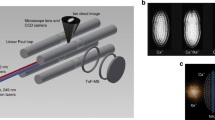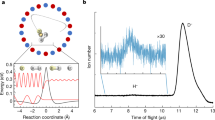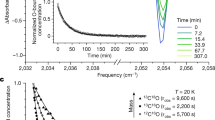Abstract
IT seems to be generally assumed that diplogen will always react more slowly than hydrogen. As I may partly be responsible for this view1, I should like to point out that this is not always correct. Lower reactivity of diplogen compared with hydrogen results mainly from two causes: (1) the existence of zero point energy: and (2) the quantum mechanical leakage of particles through energy barriers. Whilst the leakage through the barrier is always greater for the hydrogen than for the diplogen atoms, the effect of the zero point energy may occasionally favour the reverse ratio. I will confine myself to one special case, as the general treatment will be published shortly by C. E. H. Bawn and G. Ogden. Compare the reaction of a free hydrogen and a diplogen atom ; in the initial state the atoms possess no zero point energy and their energies will be equal. However, at the top of the barrier there will be a zero point energy present2, and this will be greater for the complex reacting with the hydrogen atom than for that reacting with the diplogen atom. The effect of the zero point energy at the top of the barrier is, therefore, to increase the activation energy of the hydrogen atoms to a greater extent than that of the diplogen atoms.
This is a preview of subscription content, access via your institution
Access options
Subscribe to this journal
Receive 51 print issues and online access
$199.00 per year
only $3.90 per issue
Buy this article
- Purchase on Springer Link
- Instant access to full article PDF
Prices may be subject to local taxes which are calculated during checkout
Similar content being viewed by others
References
Cremer and Polanyi, Z. phys. Chem., 19 B, 443 ; 1932. See also Eyring, Proc. Nat. Acad. Sci., 19, 78; 1933.
Eyring and Polanyi, Z. phys. Chem., 12 B, 279 ; 1931.
Author information
Authors and Affiliations
Rights and permissions
About this article
Cite this article
POLANYI, M. Reaction Rates of the Hydrogen Isotopes. Nature 133, 26–27 (1934). https://doi.org/10.1038/133026b0
Issue Date:
DOI: https://doi.org/10.1038/133026b0
This article is cited by
-
Strong inverse kinetic isotope effect observed in ammonia charge exchange reactions
Nature Communications (2020)
-
Idrogeno pesante ed acqua pesante
Il Nuovo Cimento (1934)
-
Das schwere Wasserstoffisotop
Die Naturwissenschaften (1934)
Comments
By submitting a comment you agree to abide by our Terms and Community Guidelines. If you find something abusive or that does not comply with our terms or guidelines please flag it as inappropriate.



